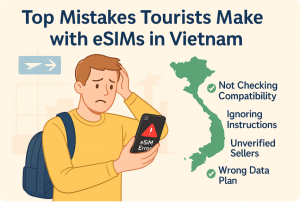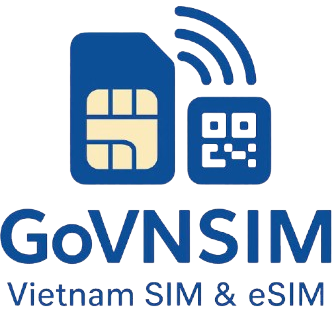No products in the cart.
Top Mistakes Tourists Make with eSIMs in Vietnam
Top Mistakes Tourists Make with eSIMs in Vietnam can easily disrupt your travel plans if you’re not well-prepared. As Vietnam’s eSIM market grows, more travelers are choosing eSIMs for seamless connectivity—but many fall into common traps. This guide reveals the top mistakes tourists make with eSIMs in Vietnam and provides proven solutions so you can avoid hassle and enjoy your trip with reliable mobile data.
Top Mistakes Tourists Make with eSIMs in Vietnam: Why It Matters
Understanding the top mistakes tourists make with eSIMs in Vietnam is crucial. The convenience of digital SIMs is matched only by the risk of mishaps if you skip important steps. Let’s break down the most common issues that catch travelers off guard and how to prevent them.

Top Mistakes Tourists Make with eSIMs in Vietnam: Common Compatibility Issues
The top mistake tourists make with eSIMs in Vietnam is failing to check device compatibility. Not every smartphone or tablet supports eSIMs, even among new models. Before buying, go to your phone’s settings and look for an “Add eSIM” option. You can also check GSMA’s official device compatibility list (external DoFollow link).
Other Top Mistakes Tourists Make with eSIMs in Vietnam
- Purchasing eSIMs from unverified sources and getting invalid QR codes
- Skipping or misreading activation instructions
- Waiting until arrival in Vietnam to activate, then struggling with airport WiFi
- Choosing data plans without assessing real usage needs
- Not enabling data roaming or the correct SIM settings
How to Avoid the Top Mistakes Tourists Make with eSIMs in Vietnam
1. Always verify compatibility: Use the GSMA link or check your phone settings.
2. Buy from a trusted provider: Use official services like GoVnSIM (internal link) for real support and secure payment.
3. Read all instructions: Every provider may require different activation steps—do not assume the process is universal.
4. Activate before flying: This ensures you’re connected on landing and can troubleshoot with home WiFi.
5. Check and save your QR code: Store your activation email in the cloud or screenshot the QR code for backup.
6. Set up data line and roaming: Make your eSIM the default for data and turn on roaming for the eSIM profile.
Top Mistakes Tourists Make with eSIMs in Vietnam: Quick Reference Table
| Common Mistake | How to Avoid |
|---|---|
| Incompatible Device | Check GSMA’s list or phone settings before buying |
| Fake QR Code | Buy only from trusted providers |
| Missed Activation Steps | Follow provider’s instructions closely |
| Late Activation | Activate at home before departure |
| Wrong Data Plan | Estimate your usage and choose carefully |
| Data Roaming Off | Enable roaming on the eSIM |
Infographic: Top Mistakes Tourists Make with eSIMs in Vietnam
Infographic suggestion: Sora-style, vertical, colorful, checklist of “10 eSIM Mistakes” with icons: device, QR code, instruction sheet, data plan chart, globe, etc. Title bold at top, Vietnam map outline, and quick-fix tips along the side.
FAQ: Top Mistakes Tourists Make with eSIMs in Vietnam
Does every tourist in Vietnam need to check phone compatibility?
Yes, compatibility is the most common source of eSIM problems. Always confirm your device supports eSIM before you pay.
Is it risky to buy eSIMs from social media or random online stores?
Absolutely. Only purchase from trusted providers with clear support and refund policies.
What if my QR code does not work?
Contact your provider’s support immediately. If you buy from GoVnSIM, we offer quick support and backup QR codes.
WhatsApp: +84 983 074 915 | LINE ID: anyaxiaoying
Top Mistakes Tourists Make with eSIMs in Vietnam: The Cost of Errors
One of the top mistakes tourists make with eSIMs in Vietnam is underestimating the cost and inconvenience of even small errors. If your eSIM fails to activate or connect, you may face airport delays, expensive roaming fees, or wasted days searching for WiFi. The right preparation will save you time, money, and stress. Here are more pitfalls—and solutions—to ensure your Vietnam trip is hassle-free.
Top Mistakes Tourists Make with eSIMs in Vietnam: Troubleshooting & Support
Getting Help Fast: Many tourists are surprised by how tricky it can be to get quick support from global eSIM brands. Choosing a local Vietnamese eSIM provider like GoVnSIM (internal link) guarantees faster troubleshooting, local expertise, and real-time help, especially if you need urgent service or a new QR code.
Common support issues include:
- eSIM not installing due to region locks or device restrictions
- Delayed QR code emails or activation codes
- Problems with APN settings (Access Point Name)
- Misunderstanding local vs. global data coverage
Top Mistakes Tourists Make with eSIMs in Vietnam: Data Usage and Plan Selection
The top mistakes tourists make with eSIMs in Vietnam often include buying the wrong plan. Many travelers choose the cheapest plan but run out of data after just a few days. For social media, navigation, video calls, and ride-hailing apps, a minimum of 5–10GB is recommended for a week-long trip. Consider plans with a local Vietnamese phone number if you need to register for apps like Grab or food delivery.
Use the official comparison of Vietnam eSIM providers from eSIMDB.com (external DoFollow link) to compare real rates and reviews.
Top Mistakes Tourists Make with eSIMs in Vietnam: Backup and Safety Tips
Never lose access to your eSIM profile! One of the top mistakes tourists make with eSIMs in Vietnam is not backing up their activation information. Before traveling:
- Store your QR code in a secure email and cloud drive.
- Print a physical copy in case your phone is lost or broken.
- Sync all important contacts to Google/Apple accounts before switching SIM profiles.
Case Study: How Avoiding the Top Mistakes Tourists Make with eSIMs in Vietnam Can Save Your Trip
Tom, a British tourist, activated his GoVnSIM eSIM before leaving London. At Tan Son Nhat Airport, he was instantly connected, used Grab, and messaged friends—all without stress. By preparing in advance, checking compatibility, and saving his QR code, Tom avoided all the classic eSIM mistakes and had a flawless start to his Vietnam adventure.
Summary: How to Avoid the Top Mistakes Tourists Make with eSIMs in Vietnam
- Confirm your device supports eSIMs and is unlocked
- Buy from reputable, local providers with real reviews
- Read and follow activation instructions carefully
- Activate your eSIM before you fly to Vietnam
- Store your QR code securely in multiple locations
- Enable data roaming and set the eSIM as your main data line
- Choose the right data plan for your needs and budget
- Contact local support if you have issues
Further Reading & Resources
- Official guide: Apple eSIM setup instructions (external DoFollow)
- Vietnam eSIM data plans: Viettel eSIM for Vietnam (internal link)
- General eSIM info: GSMA eSIM technology (external DoFollow)
FAQ: Top Mistakes Tourists Make with eSIMs in Vietnam
Can I install a Vietnam eSIM after arriving in the country?
Yes, but it’s best to install and activate your eSIM before leaving your home country to avoid airport WiFi issues or connectivity stress.
Is a local eSIM provider better than an international one?
For Vietnam, local eSIM providers like GoVnSIM offer better support, faster solutions, and plans tailored for travelers and expats.
What’s the quickest way to fix a failed eSIM activation?
Contact your eSIM provider’s support—preferably one with local staff and instant support channels such as WhatsApp or LINE.
Do I need to enable roaming on my eSIM?
Yes, enabling data roaming on your device is essential for most Vietnam eSIMs to work correctly.
WhatsApp: +84 983 074 915 | LINE ID: anyaxiaoying
